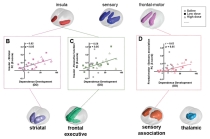Scientists have been seeking ways to identify individuals most likely to get addicted to nicotine to improve smoking prevention and cessation strategies. Using a rodent model of nicotine dependence, investigators from NIDA’s Intramural Research Program (IRP) have developed a brain-based quantitative predictor of how severe an addiction would be in specific subjects.
Scientists used an fMRI blood oxygenation level dependent (BOLD) imaging analysis of resting state data collected at baseline, prior to any drug experience. BOLD is a standard fMRI imaging technique that relies on regional differences in cerebral blood flow and oxygenation to delineate regional neuronal (brain) activity. They observed that connectivity between insular regions of the brain before drug exposure can predict dependence severity following nicotine use. Insular regions of the brain are integral to the experience of emotions, procedural memories, taste, control of motor responses, and interpersonal behavior.
This finding represents an important advance toward the development and validation of brain-based biomarkers that can predict addiction severity. It also provides a framework for future research to identify those at risk for becoming dependent on drugs and those most likely to respond to interventions, as well as for research to help create new approaches to prevention and treatment.
Study:
- Hsu, Li-Ming; Keeley, Robin J; Liang, Xia; Brynildsen, Julia K; Lu, Hanbing; Yang, Yihong; Stein, Elliot A. Intrinsic Insular-Frontal Networks Predict Future Nicotine Dependence Severity. Journal of Neuroscience.

